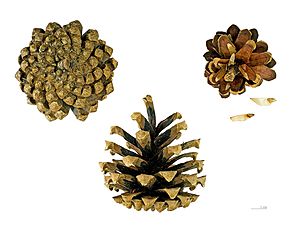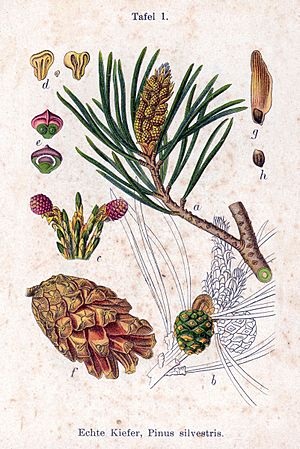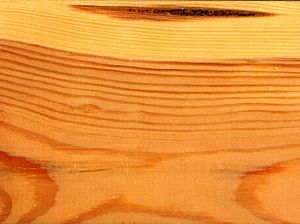Scots pine facts for kids
Quick facts for kids Scots pine |
|
|---|---|
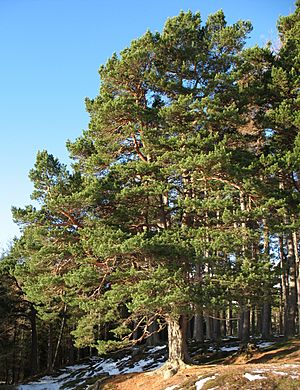 |
|
| Native Scots Pine at Glenmuick, Scotland. | |
| Conservation status | |
| Scientific classification | |
| Kingdom: | |
| Division: | |
| Class: | |
| Order: | |
| Family: | |
| Genus: | |
| Subgenus: |
Pinus
|
| Species: |
P. sylvestris
|
| Binomial name | |
| Pinus sylvestris |
|
 |
|
| Distribution | |
Scots Pine (Pinus sylvestris) is a species of pine native to Europe and Asia. It ranges from Scotland, Ireland and Portugal in the west, east to eastern Siberia, south to the Caucasus Mountains, and as far north as well inside the Arctic Circle in Scandinavia.
In the north of its range, it occurs from sea level to 1,000 m, while in the south of its range it is a high altitude mountain tree, growing at 1,200–2,600 m altitude.
It has fairly short, blue-green leaves and orange-red bark.
Description

Pinus sylvestris is an evergreen coniferous tree growing up to 35 m in height and 1 m trunk diameter when mature, exceptionally over 45 metres (148 ft) tall and 1.7 metres (5 ft 7 in) trunk diameter on very productive sites, the tallest on record being a more than 210-year-old tree growing in Estonia which stands at 46.6 m (152 ft 11 in).
The bark is thick, scaly dark grey-brown on the lower trunk, and thin, flaky and orange on the upper trunk and branches. The habit of the mature tree is distinctive due to its long, bare and straight trunk topped by a rounded or flat-topped mass of foliage. The lifespan is normally 150–300 years, with the oldest recorded specimens in Lapland, Northern Finland over 760 years.
The shoots are light brown, with a spirally arranged scale-like pattern. On mature trees the leaves ('needles') are a glaucous blue-green, often darker green to dark yellow-green in winter, 2.5–5 cm (1–2 in) long and 1–2 mm (1⁄32–3⁄32 in) broad, produced in fascicles of two with a persistent grey 5–10 mm (1⁄4–3⁄8 in) basal sheath. On vigorous young trees the leaves can be twice as long, and occasionally occur in fascicles of three or four on the tips of strong shoots. Leaf persistence varies from two to four years in warmer climates, and up to nine years in subarctic regions. Seedlings up to one year old bear juvenile leaves; these are single (not in pairs), 2–3 cm (3⁄4–1+1⁄4 in) long, flattened, with a serrated margin.
The seed cones are red at pollination, then pale brown, globose and 4–8 mm (5⁄32–5⁄16 in) diameter in their first year, expanding to full size in their second year, pointed ovoid-conic, green, then grey-green to yellow-brown at maturity, 3–7.5 cm (1+1⁄8–3 in) long. The cone scales have a flat to pyramidal apophysis (the external part of the cone scale), with a small prickle on the umbo (central boss or protuberance). The seeds are blackish, 3–5 mm (1⁄8–3⁄16 in) in length with a pale brown 12–20 mm (15⁄32–25⁄32 in) wing and are released when the cones open in spring 22–24 months after pollination. The pollen cones are yellow, occasionally pink, 8–12 mm (5⁄16–15⁄32 in) long; pollen release is in mid to late spring.
Distribution
Scots pine is the only pine native to northern Europe, forming either pure forests or mixed with Norway spruce, common juniper, silver birch, European rowan, Eurasian aspen and other hardwood species. In central and southern Europe, it occurs with numerous additional species, including European black pine, mountain pine, Macedonian pine, and Swiss pine. In the eastern part of its range, it occurs with Siberian pine, among others.
Cultivation and uses
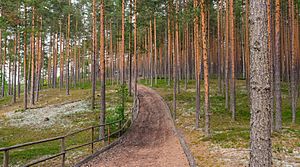
Scots pine is an important tree in forestry. The wood is used for pulp and sawn timber products. A seedling stand can be created by planting, sowing, or natural regeneration. Commercial plantation rotations vary between 50 and 120 years, with longer rotations in northeastern areas where growth is slower.
In Scandinavian countries, Scots pine was used for making tar in the preindustrial age. Some active tar producers still exist, but mostly the industry has ceased. The pine has also been used as a source of rosin and turpentine.
The wood is pale brown to red-brown, and used for general construction work. It has a dry density around 470 kg/m3 (varying with growth conditions), an open porosity of 60%, a fibre saturation point of 0.25 kg/kg, and a saturation moisture content of 1.60 kg/kg. Scots pine fibres are used to make the textile known as vegetable flannel, which has a hemp-like appearance, but with a tighter, softer texture.
Scots pine has also been widely planted in New Zealand and much of the colder regions of North America; it was one of the first trees introduced to North America, in about 1600. It is listed as an invasive species in some areas there, including Ontario, Michigan and Wisconsin. It has been widely used in the United States for the Christmas tree trade, and was one of the most popular Christmas trees from the 1950s through the 1980s. It remains popular for that usage, though it has been eclipsed in popularity, by such species as Fraser fir, Douglas-fir, and others. Despite its invasiveness in parts of eastern North America, Scots pine does not often grow well there, partly due to climate and soil differences between its native habitat and that of North America, and partly due to damage by pests and diseases; the tree often grows in a twisted, haphazard manner if not tended to (as they are in the Christmas tree trade). Scots pines may be killed by the pine wood nematode, which causes pine wilt disease. The nematode most often attacks trees that are at least ten years old and often kills trees it infects within a few weeks.
Several cultivars are grown for ornamental purposes in parks and large gardens, of which 'Aurea', 'Beuvronensis', 'Frensham', and 'Gold Coin' have gained the Royal Horticultural Society's Award of Garden Merit.
The Scots pine was grown and used extensively in the coal mining regions of Flanders, Belgium. It was used to fortify the tunnelling and preferred for its cracking sound when in need of replacing. Large patches of forest containing mostly this species are still scattered over the countryside.
Images for kids
-
Roots of an old pine in Ystad, Sweden
See also
 In Spanish: Pino silvestre para niños
In Spanish: Pino silvestre para niños



